Procurement Contract Management Case Study: CQU Expansion Project
VerifiedAdded on 2022/11/24
|11
|2879
|119
Case Study
AI Summary
This case study examines the procurement and contract management strategies employed by Central Queensland University (CQU) for its Melbourne campus expansion project. The university, experiencing increased student enrollment, plans to construct a new campus including a lecture building, laboratories, a motel, and a conference hall. The assignment details the project lifecycle, from concept to commissioning, highlighting the role of the project manager and the contractor, PPMP20011 Company. It explores various procurement routes, with the design and build option being recommended, and discusses the chosen cost-plus contract. The case study also identifies potential risks, such as budget, event, and scope risks, and emphasizes the importance of a risk management plan. The project's budget allocation for each structure (lecture building, conference hall, and motel) is also provided. The analysis aims to provide a comprehensive overview of the project's procurement and contract management aspects, offering insights into the challenges and strategies involved in large-scale construction projects within a university setting.
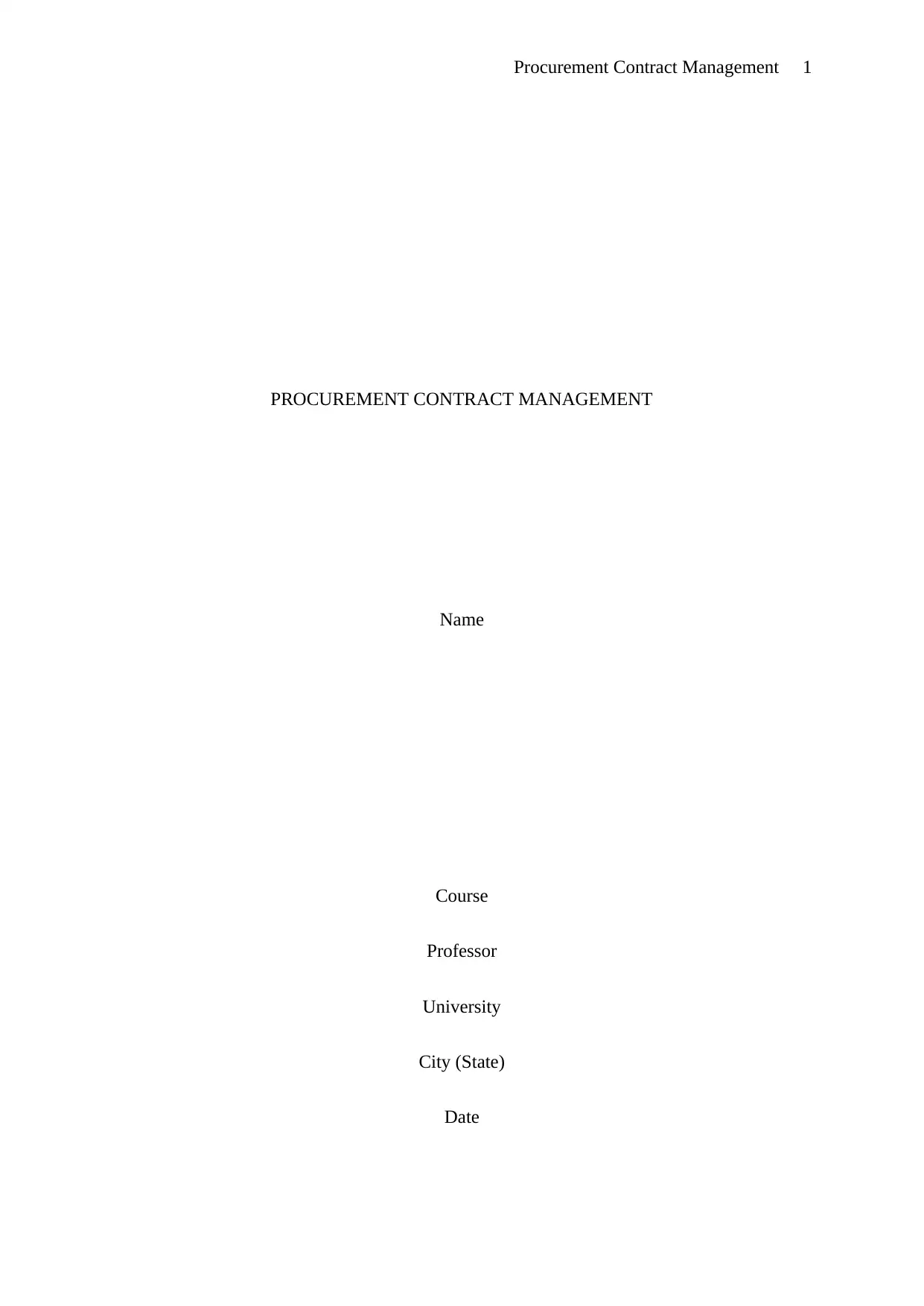
Procurement Contract Management 1
PROCUREMENT CONTRACT MANAGEMENT
Name
Course
Professor
University
City (State)
Date
PROCUREMENT CONTRACT MANAGEMENT
Name
Course
Professor
University
City (State)
Date
Paraphrase This Document
Need a fresh take? Get an instant paraphrase of this document with our AI Paraphraser
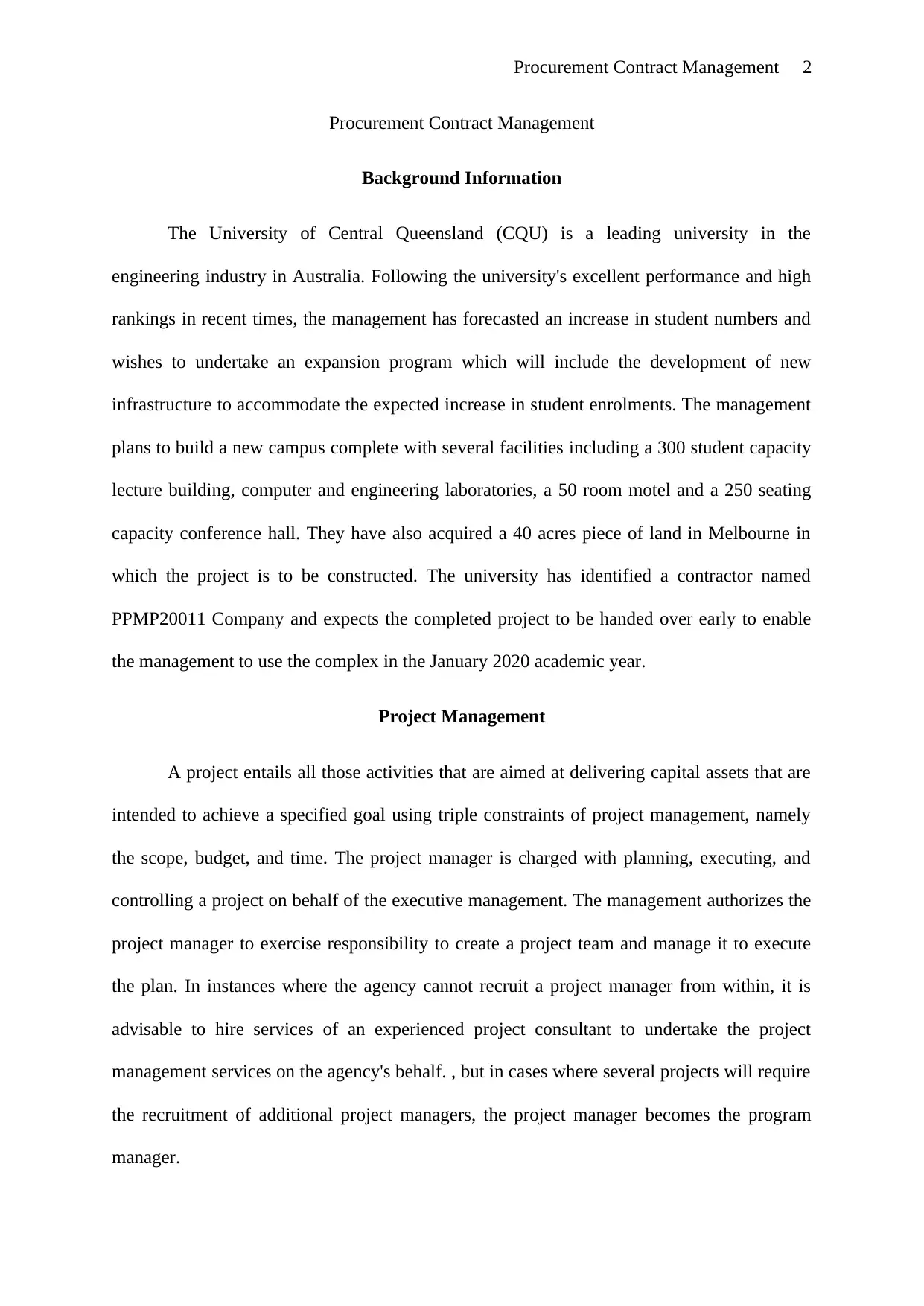
Procurement Contract Management 2
Procurement Contract Management
Background Information
The University of Central Queensland (CQU) is a leading university in the
engineering industry in Australia. Following the university's excellent performance and high
rankings in recent times, the management has forecasted an increase in student numbers and
wishes to undertake an expansion program which will include the development of new
infrastructure to accommodate the expected increase in student enrolments. The management
plans to build a new campus complete with several facilities including a 300 student capacity
lecture building, computer and engineering laboratories, a 50 room motel and a 250 seating
capacity conference hall. They have also acquired a 40 acres piece of land in Melbourne in
which the project is to be constructed. The university has identified a contractor named
PPMP20011 Company and expects the completed project to be handed over early to enable
the management to use the complex in the January 2020 academic year.
Project Management
A project entails all those activities that are aimed at delivering capital assets that are
intended to achieve a specified goal using triple constraints of project management, namely
the scope, budget, and time. The project manager is charged with planning, executing, and
controlling a project on behalf of the executive management. The management authorizes the
project manager to exercise responsibility to create a project team and manage it to execute
the plan. In instances where the agency cannot recruit a project manager from within, it is
advisable to hire services of an experienced project consultant to undertake the project
management services on the agency's behalf. , but in cases where several projects will require
the recruitment of additional project managers, the project manager becomes the program
manager.
Procurement Contract Management
Background Information
The University of Central Queensland (CQU) is a leading university in the
engineering industry in Australia. Following the university's excellent performance and high
rankings in recent times, the management has forecasted an increase in student numbers and
wishes to undertake an expansion program which will include the development of new
infrastructure to accommodate the expected increase in student enrolments. The management
plans to build a new campus complete with several facilities including a 300 student capacity
lecture building, computer and engineering laboratories, a 50 room motel and a 250 seating
capacity conference hall. They have also acquired a 40 acres piece of land in Melbourne in
which the project is to be constructed. The university has identified a contractor named
PPMP20011 Company and expects the completed project to be handed over early to enable
the management to use the complex in the January 2020 academic year.
Project Management
A project entails all those activities that are aimed at delivering capital assets that are
intended to achieve a specified goal using triple constraints of project management, namely
the scope, budget, and time. The project manager is charged with planning, executing, and
controlling a project on behalf of the executive management. The management authorizes the
project manager to exercise responsibility to create a project team and manage it to execute
the plan. In instances where the agency cannot recruit a project manager from within, it is
advisable to hire services of an experienced project consultant to undertake the project
management services on the agency's behalf. , but in cases where several projects will require
the recruitment of additional project managers, the project manager becomes the program
manager.
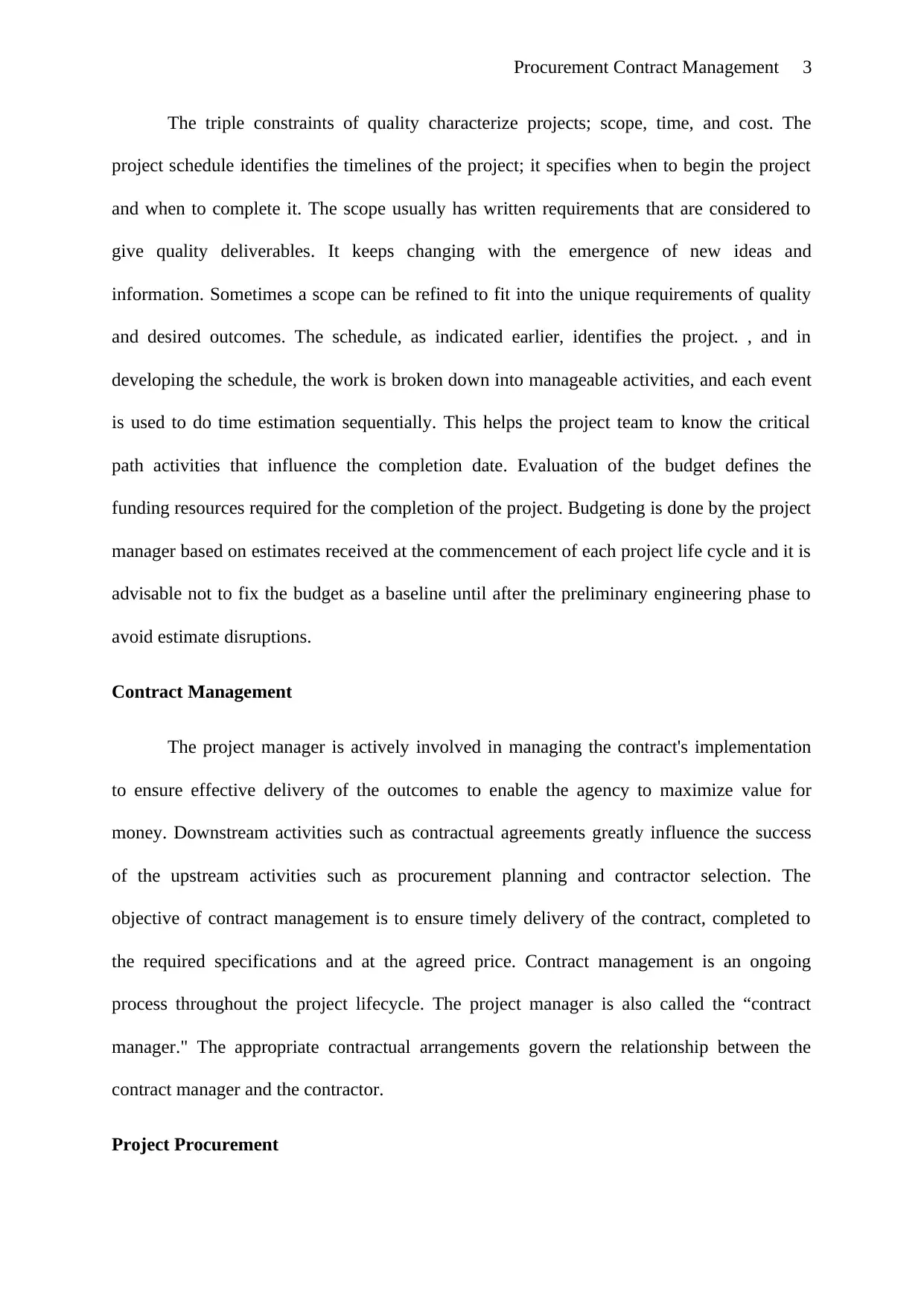
Procurement Contract Management 3
The triple constraints of quality characterize projects; scope, time, and cost. The
project schedule identifies the timelines of the project; it specifies when to begin the project
and when to complete it. The scope usually has written requirements that are considered to
give quality deliverables. It keeps changing with the emergence of new ideas and
information. Sometimes a scope can be refined to fit into the unique requirements of quality
and desired outcomes. The schedule, as indicated earlier, identifies the project. , and in
developing the schedule, the work is broken down into manageable activities, and each event
is used to do time estimation sequentially. This helps the project team to know the critical
path activities that influence the completion date. Evaluation of the budget defines the
funding resources required for the completion of the project. Budgeting is done by the project
manager based on estimates received at the commencement of each project life cycle and it is
advisable not to fix the budget as a baseline until after the preliminary engineering phase to
avoid estimate disruptions.
Contract Management
The project manager is actively involved in managing the contract's implementation
to ensure effective delivery of the outcomes to enable the agency to maximize value for
money. Downstream activities such as contractual agreements greatly influence the success
of the upstream activities such as procurement planning and contractor selection. The
objective of contract management is to ensure timely delivery of the contract, completed to
the required specifications and at the agreed price. Contract management is an ongoing
process throughout the project lifecycle. The project manager is also called the “contract
manager." The appropriate contractual arrangements govern the relationship between the
contract manager and the contractor.
Project Procurement
The triple constraints of quality characterize projects; scope, time, and cost. The
project schedule identifies the timelines of the project; it specifies when to begin the project
and when to complete it. The scope usually has written requirements that are considered to
give quality deliverables. It keeps changing with the emergence of new ideas and
information. Sometimes a scope can be refined to fit into the unique requirements of quality
and desired outcomes. The schedule, as indicated earlier, identifies the project. , and in
developing the schedule, the work is broken down into manageable activities, and each event
is used to do time estimation sequentially. This helps the project team to know the critical
path activities that influence the completion date. Evaluation of the budget defines the
funding resources required for the completion of the project. Budgeting is done by the project
manager based on estimates received at the commencement of each project life cycle and it is
advisable not to fix the budget as a baseline until after the preliminary engineering phase to
avoid estimate disruptions.
Contract Management
The project manager is actively involved in managing the contract's implementation
to ensure effective delivery of the outcomes to enable the agency to maximize value for
money. Downstream activities such as contractual agreements greatly influence the success
of the upstream activities such as procurement planning and contractor selection. The
objective of contract management is to ensure timely delivery of the contract, completed to
the required specifications and at the agreed price. Contract management is an ongoing
process throughout the project lifecycle. The project manager is also called the “contract
manager." The appropriate contractual arrangements govern the relationship between the
contract manager and the contractor.
Project Procurement
You're viewing a preview
Unlock full access by subscribing today!
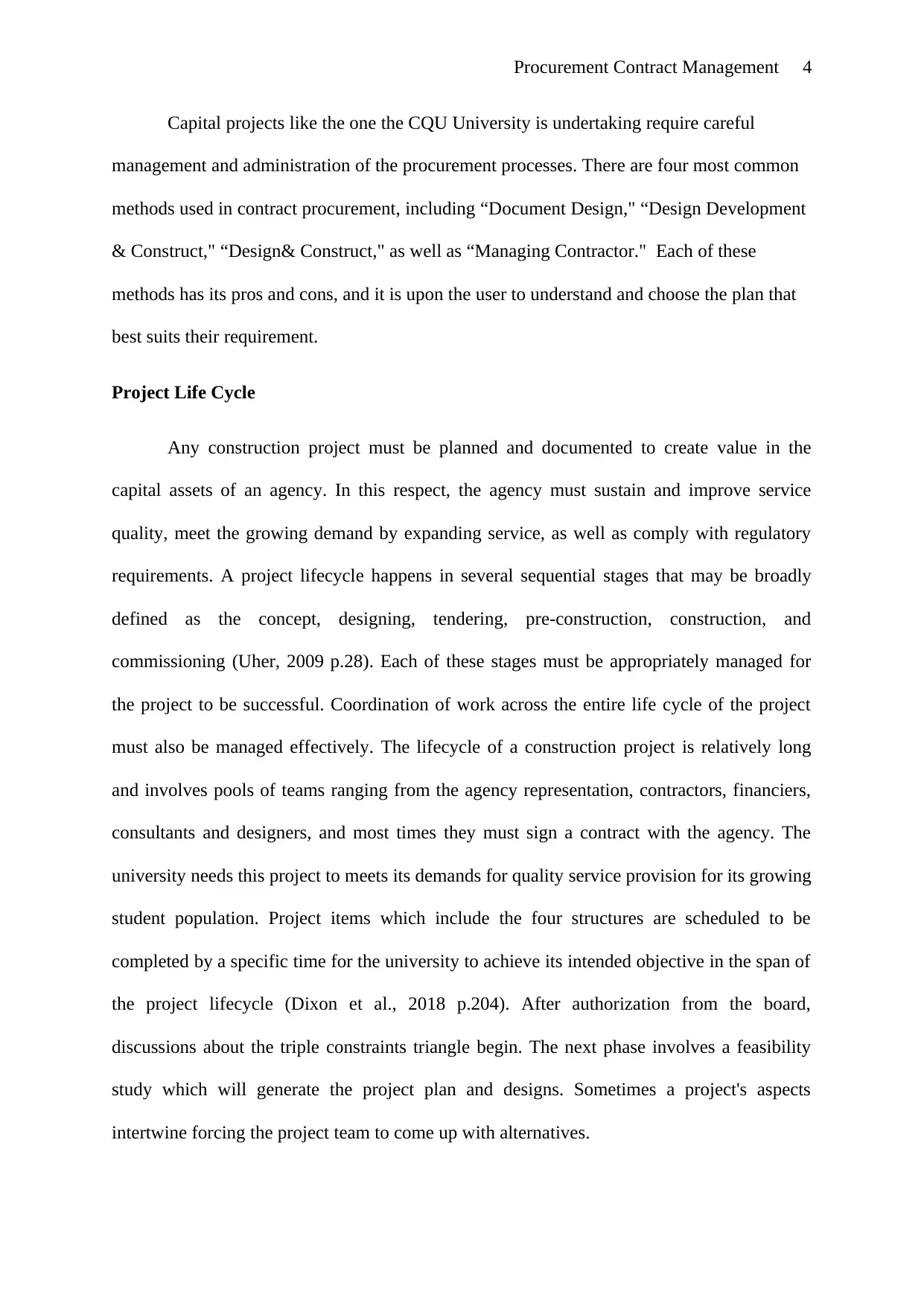
Procurement Contract Management 4
Capital projects like the one the CQU University is undertaking require careful
management and administration of the procurement processes. There are four most common
methods used in contract procurement, including “Document Design," “Design Development
& Construct," “Design& Construct," as well as “Managing Contractor." Each of these
methods has its pros and cons, and it is upon the user to understand and choose the plan that
best suits their requirement.
Project Life Cycle
Any construction project must be planned and documented to create value in the
capital assets of an agency. In this respect, the agency must sustain and improve service
quality, meet the growing demand by expanding service, as well as comply with regulatory
requirements. A project lifecycle happens in several sequential stages that may be broadly
defined as the concept, designing, tendering, pre-construction, construction, and
commissioning (Uher, 2009 p.28). Each of these stages must be appropriately managed for
the project to be successful. Coordination of work across the entire life cycle of the project
must also be managed effectively. The lifecycle of a construction project is relatively long
and involves pools of teams ranging from the agency representation, contractors, financiers,
consultants and designers, and most times they must sign a contract with the agency. The
university needs this project to meets its demands for quality service provision for its growing
student population. Project items which include the four structures are scheduled to be
completed by a specific time for the university to achieve its intended objective in the span of
the project lifecycle (Dixon et al., 2018 p.204). After authorization from the board,
discussions about the triple constraints triangle begin. The next phase involves a feasibility
study which will generate the project plan and designs. Sometimes a project's aspects
intertwine forcing the project team to come up with alternatives.
Capital projects like the one the CQU University is undertaking require careful
management and administration of the procurement processes. There are four most common
methods used in contract procurement, including “Document Design," “Design Development
& Construct," “Design& Construct," as well as “Managing Contractor." Each of these
methods has its pros and cons, and it is upon the user to understand and choose the plan that
best suits their requirement.
Project Life Cycle
Any construction project must be planned and documented to create value in the
capital assets of an agency. In this respect, the agency must sustain and improve service
quality, meet the growing demand by expanding service, as well as comply with regulatory
requirements. A project lifecycle happens in several sequential stages that may be broadly
defined as the concept, designing, tendering, pre-construction, construction, and
commissioning (Uher, 2009 p.28). Each of these stages must be appropriately managed for
the project to be successful. Coordination of work across the entire life cycle of the project
must also be managed effectively. The lifecycle of a construction project is relatively long
and involves pools of teams ranging from the agency representation, contractors, financiers,
consultants and designers, and most times they must sign a contract with the agency. The
university needs this project to meets its demands for quality service provision for its growing
student population. Project items which include the four structures are scheduled to be
completed by a specific time for the university to achieve its intended objective in the span of
the project lifecycle (Dixon et al., 2018 p.204). After authorization from the board,
discussions about the triple constraints triangle begin. The next phase involves a feasibility
study which will generate the project plan and designs. Sometimes a project's aspects
intertwine forcing the project team to come up with alternatives.
Paraphrase This Document
Need a fresh take? Get an instant paraphrase of this document with our AI Paraphraser
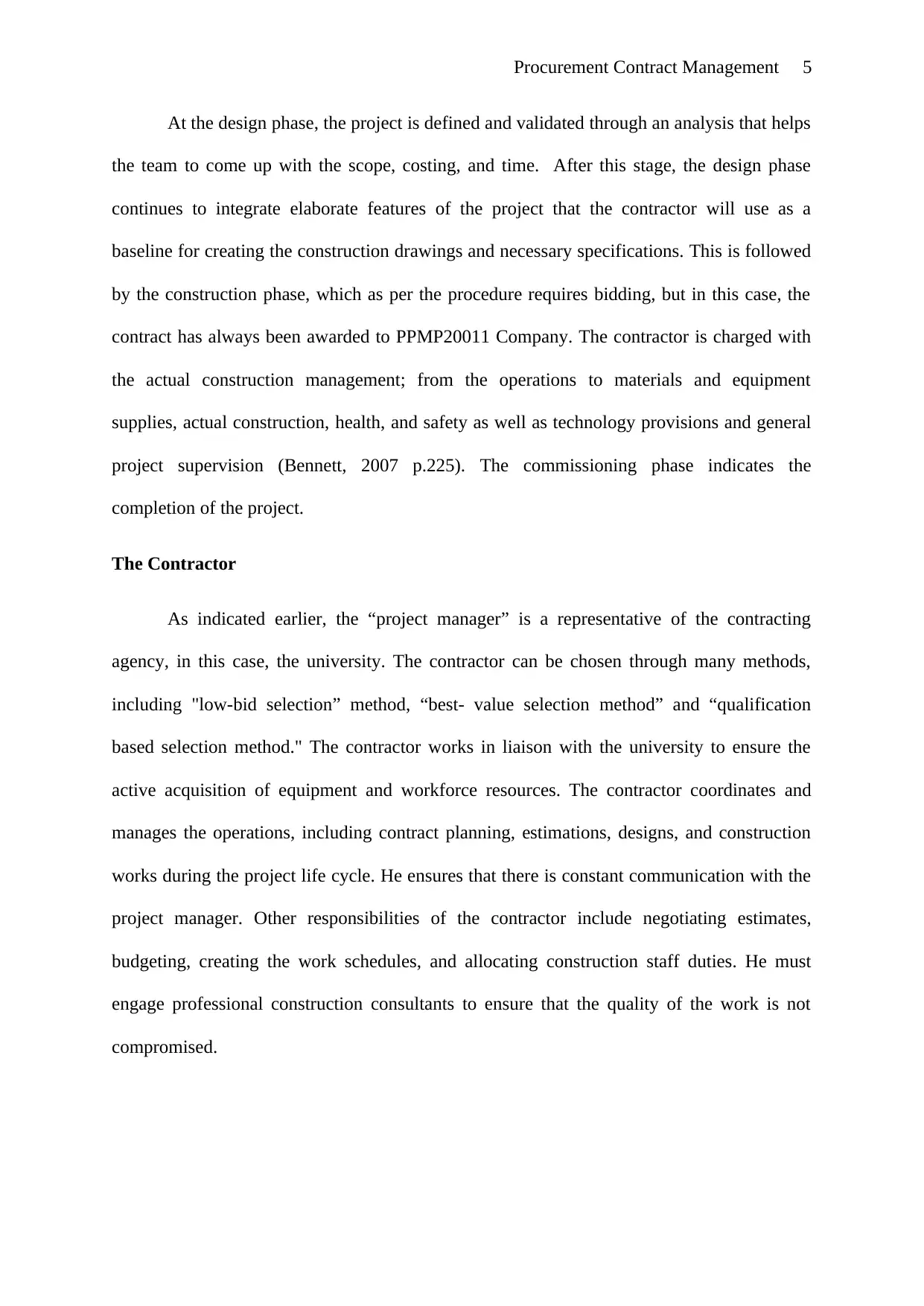
Procurement Contract Management 5
At the design phase, the project is defined and validated through an analysis that helps
the team to come up with the scope, costing, and time. After this stage, the design phase
continues to integrate elaborate features of the project that the contractor will use as a
baseline for creating the construction drawings and necessary specifications. This is followed
by the construction phase, which as per the procedure requires bidding, but in this case, the
contract has always been awarded to PPMP20011 Company. The contractor is charged with
the actual construction management; from the operations to materials and equipment
supplies, actual construction, health, and safety as well as technology provisions and general
project supervision (Bennett, 2007 p.225). The commissioning phase indicates the
completion of the project.
The Contractor
As indicated earlier, the “project manager” is a representative of the contracting
agency, in this case, the university. The contractor can be chosen through many methods,
including "low-bid selection” method, “best- value selection method” and “qualification
based selection method." The contractor works in liaison with the university to ensure the
active acquisition of equipment and workforce resources. The contractor coordinates and
manages the operations, including contract planning, estimations, designs, and construction
works during the project life cycle. He ensures that there is constant communication with the
project manager. Other responsibilities of the contractor include negotiating estimates,
budgeting, creating the work schedules, and allocating construction staff duties. He must
engage professional construction consultants to ensure that the quality of the work is not
compromised.
At the design phase, the project is defined and validated through an analysis that helps
the team to come up with the scope, costing, and time. After this stage, the design phase
continues to integrate elaborate features of the project that the contractor will use as a
baseline for creating the construction drawings and necessary specifications. This is followed
by the construction phase, which as per the procedure requires bidding, but in this case, the
contract has always been awarded to PPMP20011 Company. The contractor is charged with
the actual construction management; from the operations to materials and equipment
supplies, actual construction, health, and safety as well as technology provisions and general
project supervision (Bennett, 2007 p.225). The commissioning phase indicates the
completion of the project.
The Contractor
As indicated earlier, the “project manager” is a representative of the contracting
agency, in this case, the university. The contractor can be chosen through many methods,
including "low-bid selection” method, “best- value selection method” and “qualification
based selection method." The contractor works in liaison with the university to ensure the
active acquisition of equipment and workforce resources. The contractor coordinates and
manages the operations, including contract planning, estimations, designs, and construction
works during the project life cycle. He ensures that there is constant communication with the
project manager. Other responsibilities of the contractor include negotiating estimates,
budgeting, creating the work schedules, and allocating construction staff duties. He must
engage professional construction consultants to ensure that the quality of the work is not
compromised.
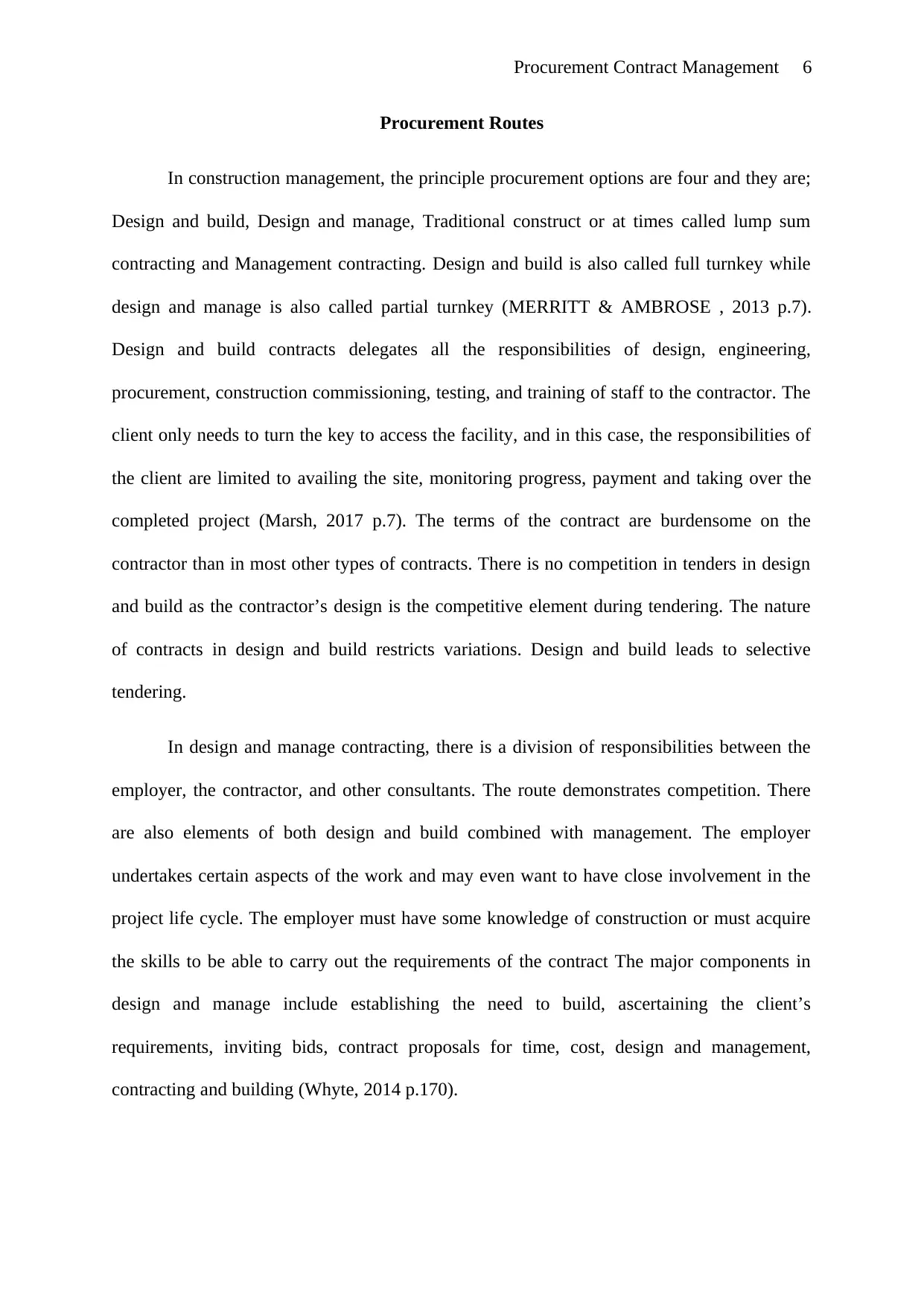
Procurement Contract Management 6
Procurement Routes
In construction management, the principle procurement options are four and they are;
Design and build, Design and manage, Traditional construct or at times called lump sum
contracting and Management contracting. Design and build is also called full turnkey while
design and manage is also called partial turnkey (MERRITT & AMBROSE , 2013 p.7).
Design and build contracts delegates all the responsibilities of design, engineering,
procurement, construction commissioning, testing, and training of staff to the contractor. The
client only needs to turn the key to access the facility, and in this case, the responsibilities of
the client are limited to availing the site, monitoring progress, payment and taking over the
completed project (Marsh, 2017 p.7). The terms of the contract are burdensome on the
contractor than in most other types of contracts. There is no competition in tenders in design
and build as the contractor’s design is the competitive element during tendering. The nature
of contracts in design and build restricts variations. Design and build leads to selective
tendering.
In design and manage contracting, there is a division of responsibilities between the
employer, the contractor, and other consultants. The route demonstrates competition. There
are also elements of both design and build combined with management. The employer
undertakes certain aspects of the work and may even want to have close involvement in the
project life cycle. The employer must have some knowledge of construction or must acquire
the skills to be able to carry out the requirements of the contract The major components in
design and manage include establishing the need to build, ascertaining the client’s
requirements, inviting bids, contract proposals for time, cost, design and management,
contracting and building (Whyte, 2014 p.170).
Procurement Routes
In construction management, the principle procurement options are four and they are;
Design and build, Design and manage, Traditional construct or at times called lump sum
contracting and Management contracting. Design and build is also called full turnkey while
design and manage is also called partial turnkey (MERRITT & AMBROSE , 2013 p.7).
Design and build contracts delegates all the responsibilities of design, engineering,
procurement, construction commissioning, testing, and training of staff to the contractor. The
client only needs to turn the key to access the facility, and in this case, the responsibilities of
the client are limited to availing the site, monitoring progress, payment and taking over the
completed project (Marsh, 2017 p.7). The terms of the contract are burdensome on the
contractor than in most other types of contracts. There is no competition in tenders in design
and build as the contractor’s design is the competitive element during tendering. The nature
of contracts in design and build restricts variations. Design and build leads to selective
tendering.
In design and manage contracting, there is a division of responsibilities between the
employer, the contractor, and other consultants. The route demonstrates competition. There
are also elements of both design and build combined with management. The employer
undertakes certain aspects of the work and may even want to have close involvement in the
project life cycle. The employer must have some knowledge of construction or must acquire
the skills to be able to carry out the requirements of the contract The major components in
design and manage include establishing the need to build, ascertaining the client’s
requirements, inviting bids, contract proposals for time, cost, design and management,
contracting and building (Whyte, 2014 p.170).
You're viewing a preview
Unlock full access by subscribing today!
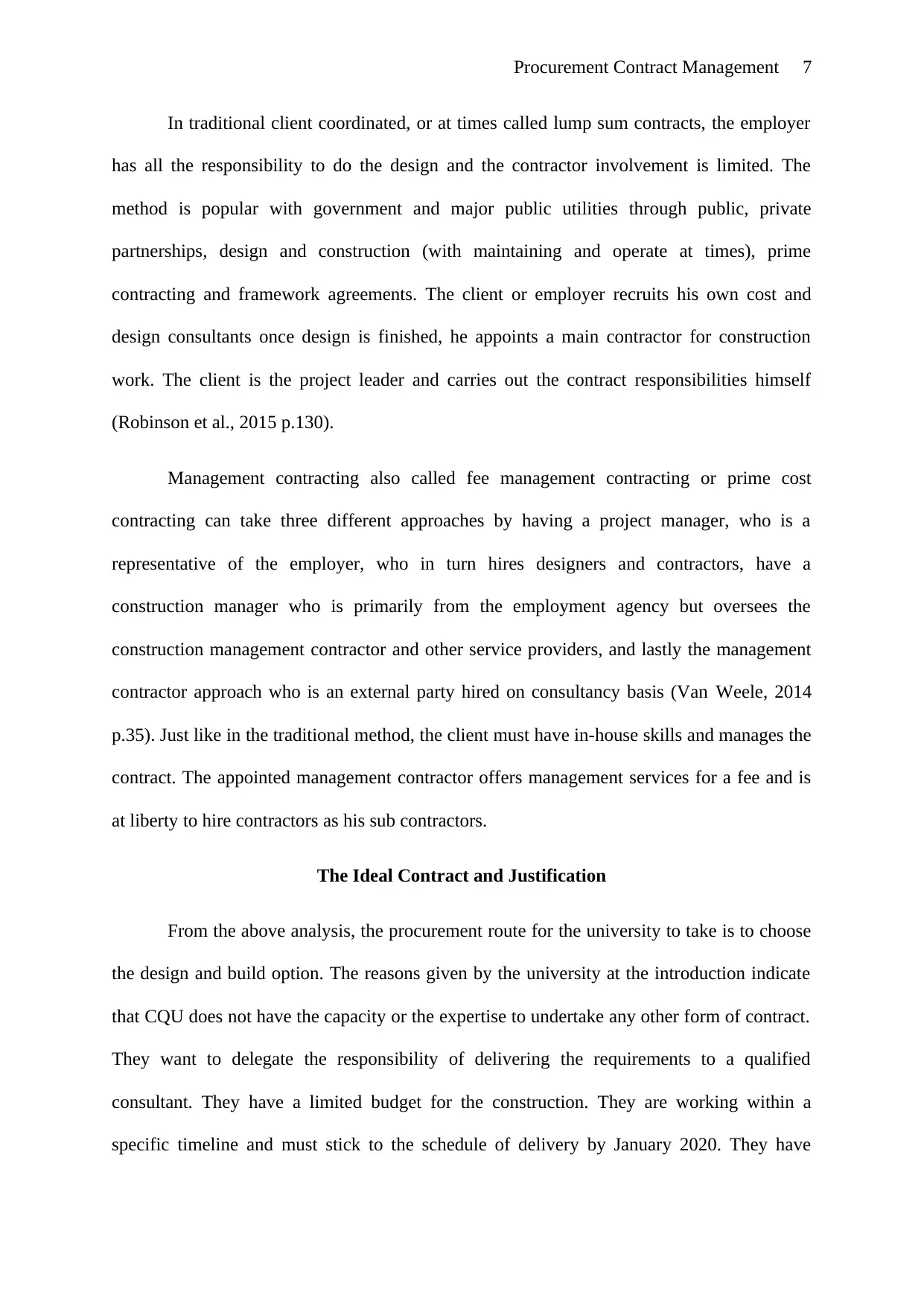
Procurement Contract Management 7
In traditional client coordinated, or at times called lump sum contracts, the employer
has all the responsibility to do the design and the contractor involvement is limited. The
method is popular with government and major public utilities through public, private
partnerships, design and construction (with maintaining and operate at times), prime
contracting and framework agreements. The client or employer recruits his own cost and
design consultants once design is finished, he appoints a main contractor for construction
work. The client is the project leader and carries out the contract responsibilities himself
(Robinson et al., 2015 p.130).
Management contracting also called fee management contracting or prime cost
contracting can take three different approaches by having a project manager, who is a
representative of the employer, who in turn hires designers and contractors, have a
construction manager who is primarily from the employment agency but oversees the
construction management contractor and other service providers, and lastly the management
contractor approach who is an external party hired on consultancy basis (Van Weele, 2014
p.35). Just like in the traditional method, the client must have in-house skills and manages the
contract. The appointed management contractor offers management services for a fee and is
at liberty to hire contractors as his sub contractors.
The Ideal Contract and Justification
From the above analysis, the procurement route for the university to take is to choose
the design and build option. The reasons given by the university at the introduction indicate
that CQU does not have the capacity or the expertise to undertake any other form of contract.
They want to delegate the responsibility of delivering the requirements to a qualified
consultant. They have a limited budget for the construction. They are working within a
specific timeline and must stick to the schedule of delivery by January 2020. They have
In traditional client coordinated, or at times called lump sum contracts, the employer
has all the responsibility to do the design and the contractor involvement is limited. The
method is popular with government and major public utilities through public, private
partnerships, design and construction (with maintaining and operate at times), prime
contracting and framework agreements. The client or employer recruits his own cost and
design consultants once design is finished, he appoints a main contractor for construction
work. The client is the project leader and carries out the contract responsibilities himself
(Robinson et al., 2015 p.130).
Management contracting also called fee management contracting or prime cost
contracting can take three different approaches by having a project manager, who is a
representative of the employer, who in turn hires designers and contractors, have a
construction manager who is primarily from the employment agency but oversees the
construction management contractor and other service providers, and lastly the management
contractor approach who is an external party hired on consultancy basis (Van Weele, 2014
p.35). Just like in the traditional method, the client must have in-house skills and manages the
contract. The appointed management contractor offers management services for a fee and is
at liberty to hire contractors as his sub contractors.
The Ideal Contract and Justification
From the above analysis, the procurement route for the university to take is to choose
the design and build option. The reasons given by the university at the introduction indicate
that CQU does not have the capacity or the expertise to undertake any other form of contract.
They want to delegate the responsibility of delivering the requirements to a qualified
consultant. They have a limited budget for the construction. They are working within a
specific timeline and must stick to the schedule of delivery by January 2020. They have
Paraphrase This Document
Need a fresh take? Get an instant paraphrase of this document with our AI Paraphraser
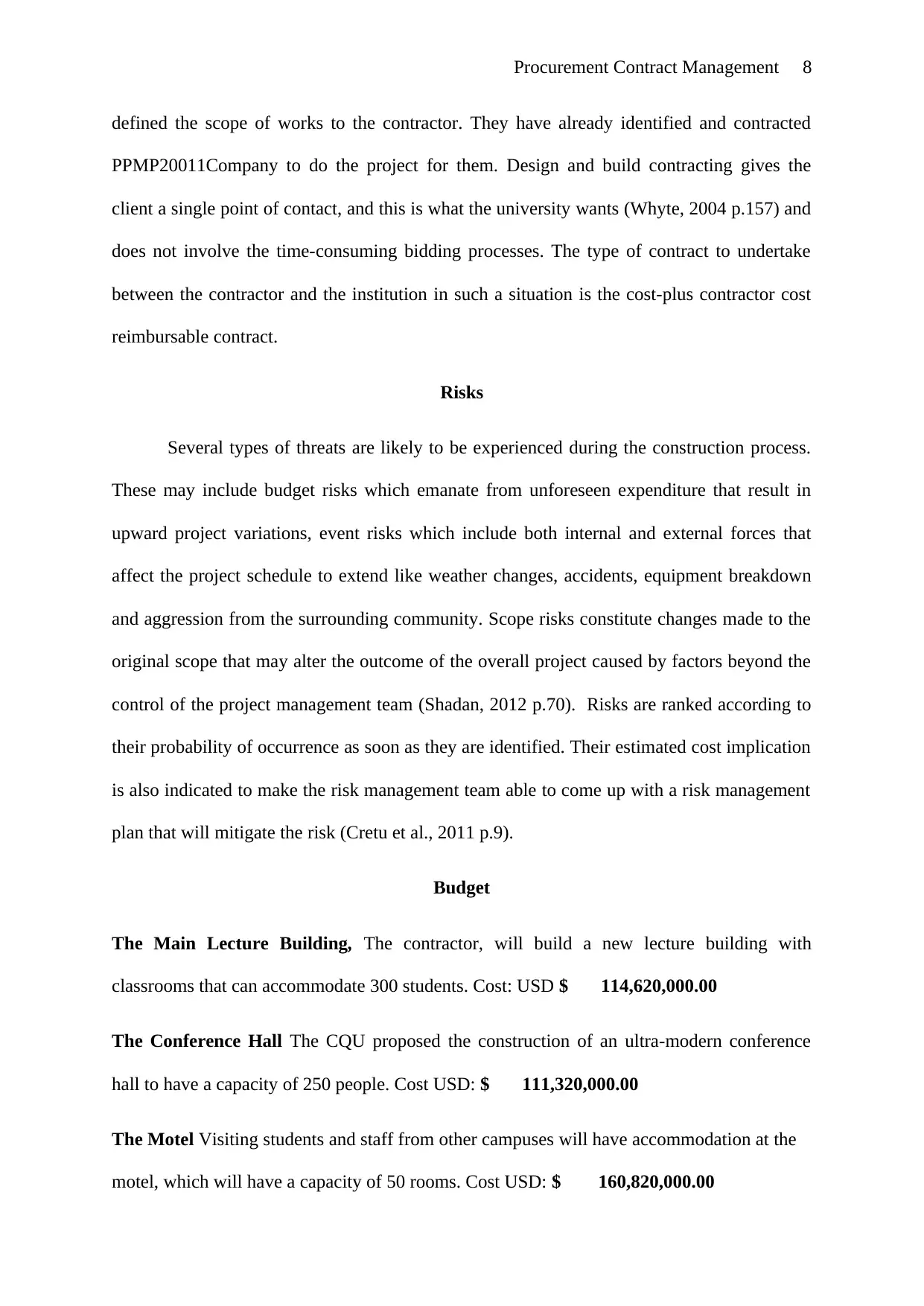
Procurement Contract Management 8
defined the scope of works to the contractor. They have already identified and contracted
PPMP20011Company to do the project for them. Design and build contracting gives the
client a single point of contact, and this is what the university wants (Whyte, 2004 p.157) and
does not involve the time-consuming bidding processes. The type of contract to undertake
between the contractor and the institution in such a situation is the cost-plus contractor cost
reimbursable contract.
Risks
Several types of threats are likely to be experienced during the construction process.
These may include budget risks which emanate from unforeseen expenditure that result in
upward project variations, event risks which include both internal and external forces that
affect the project schedule to extend like weather changes, accidents, equipment breakdown
and aggression from the surrounding community. Scope risks constitute changes made to the
original scope that may alter the outcome of the overall project caused by factors beyond the
control of the project management team (Shadan, 2012 p.70). Risks are ranked according to
their probability of occurrence as soon as they are identified. Their estimated cost implication
is also indicated to make the risk management team able to come up with a risk management
plan that will mitigate the risk (Cretu et al., 2011 p.9).
Budget
The Main Lecture Building, The contractor, will build a new lecture building with
classrooms that can accommodate 300 students. Cost: USD $ 114,620,000.00
The Conference Hall The CQU proposed the construction of an ultra-modern conference
hall to have a capacity of 250 people. Cost USD: $ 111,320,000.00
The Motel Visiting students and staff from other campuses will have accommodation at the
motel, which will have a capacity of 50 rooms. Cost USD: $ 160,820,000.00
defined the scope of works to the contractor. They have already identified and contracted
PPMP20011Company to do the project for them. Design and build contracting gives the
client a single point of contact, and this is what the university wants (Whyte, 2004 p.157) and
does not involve the time-consuming bidding processes. The type of contract to undertake
between the contractor and the institution in such a situation is the cost-plus contractor cost
reimbursable contract.
Risks
Several types of threats are likely to be experienced during the construction process.
These may include budget risks which emanate from unforeseen expenditure that result in
upward project variations, event risks which include both internal and external forces that
affect the project schedule to extend like weather changes, accidents, equipment breakdown
and aggression from the surrounding community. Scope risks constitute changes made to the
original scope that may alter the outcome of the overall project caused by factors beyond the
control of the project management team (Shadan, 2012 p.70). Risks are ranked according to
their probability of occurrence as soon as they are identified. Their estimated cost implication
is also indicated to make the risk management team able to come up with a risk management
plan that will mitigate the risk (Cretu et al., 2011 p.9).
Budget
The Main Lecture Building, The contractor, will build a new lecture building with
classrooms that can accommodate 300 students. Cost: USD $ 114,620,000.00
The Conference Hall The CQU proposed the construction of an ultra-modern conference
hall to have a capacity of 250 people. Cost USD: $ 111,320,000.00
The Motel Visiting students and staff from other campuses will have accommodation at the
motel, which will have a capacity of 50 rooms. Cost USD: $ 160,820,000.00
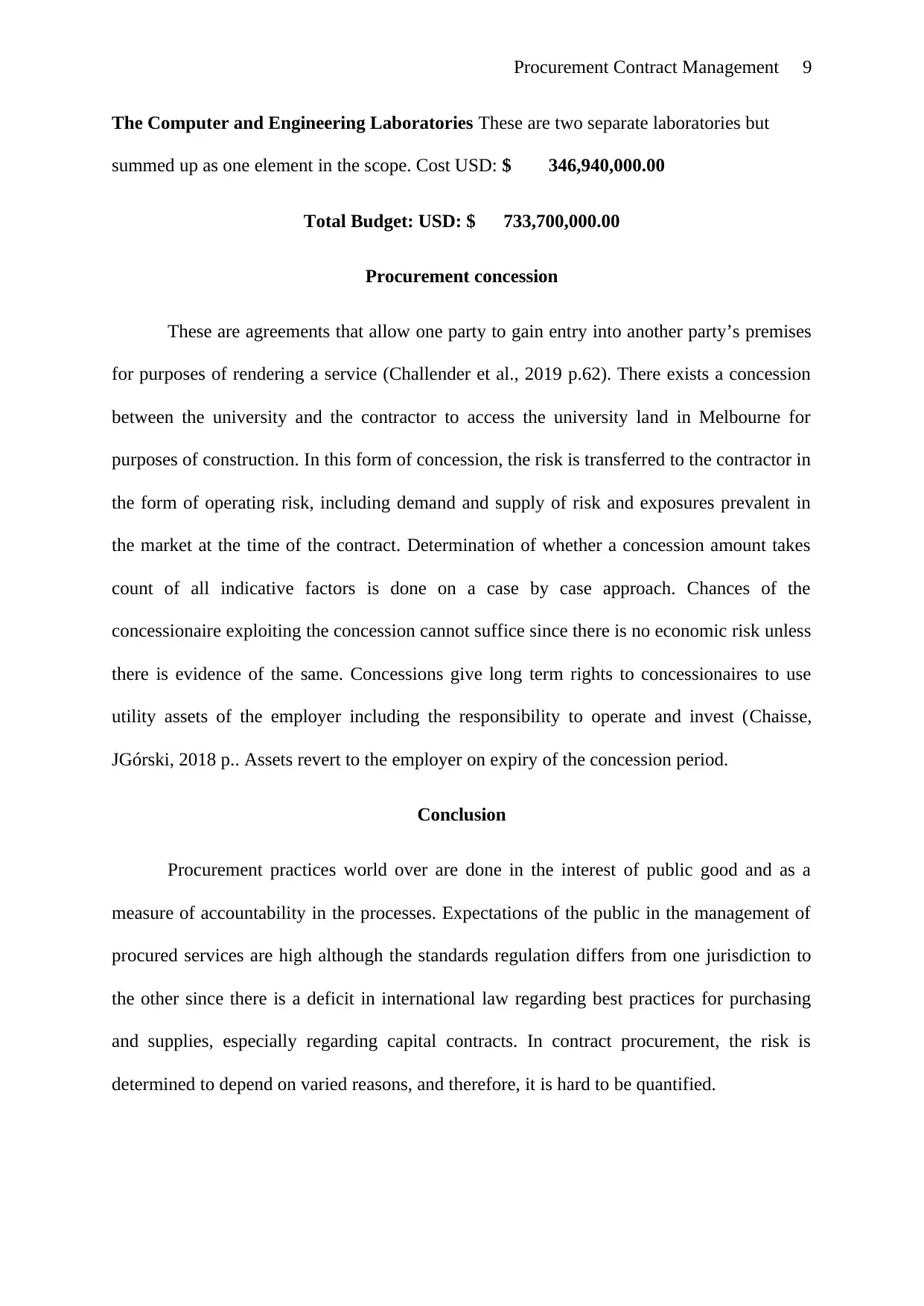
Procurement Contract Management 9
The Computer and Engineering Laboratories These are two separate laboratories but
summed up as one element in the scope. Cost USD: $ 346,940,000.00
Total Budget: USD: $ 733,700,000.00
Procurement concession
These are agreements that allow one party to gain entry into another party’s premises
for purposes of rendering a service (Challender et al., 2019 p.62). There exists a concession
between the university and the contractor to access the university land in Melbourne for
purposes of construction. In this form of concession, the risk is transferred to the contractor in
the form of operating risk, including demand and supply of risk and exposures prevalent in
the market at the time of the contract. Determination of whether a concession amount takes
count of all indicative factors is done on a case by case approach. Chances of the
concessionaire exploiting the concession cannot suffice since there is no economic risk unless
there is evidence of the same. Concessions give long term rights to concessionaires to use
utility assets of the employer including the responsibility to operate and invest (Chaisse,
JGórski, 2018 p.. Assets revert to the employer on expiry of the concession period.
Conclusion
Procurement practices world over are done in the interest of public good and as a
measure of accountability in the processes. Expectations of the public in the management of
procured services are high although the standards regulation differs from one jurisdiction to
the other since there is a deficit in international law regarding best practices for purchasing
and supplies, especially regarding capital contracts. In contract procurement, the risk is
determined to depend on varied reasons, and therefore, it is hard to be quantified.
The Computer and Engineering Laboratories These are two separate laboratories but
summed up as one element in the scope. Cost USD: $ 346,940,000.00
Total Budget: USD: $ 733,700,000.00
Procurement concession
These are agreements that allow one party to gain entry into another party’s premises
for purposes of rendering a service (Challender et al., 2019 p.62). There exists a concession
between the university and the contractor to access the university land in Melbourne for
purposes of construction. In this form of concession, the risk is transferred to the contractor in
the form of operating risk, including demand and supply of risk and exposures prevalent in
the market at the time of the contract. Determination of whether a concession amount takes
count of all indicative factors is done on a case by case approach. Chances of the
concessionaire exploiting the concession cannot suffice since there is no economic risk unless
there is evidence of the same. Concessions give long term rights to concessionaires to use
utility assets of the employer including the responsibility to operate and invest (Chaisse,
JGórski, 2018 p.. Assets revert to the employer on expiry of the concession period.
Conclusion
Procurement practices world over are done in the interest of public good and as a
measure of accountability in the processes. Expectations of the public in the management of
procured services are high although the standards regulation differs from one jurisdiction to
the other since there is a deficit in international law regarding best practices for purchasing
and supplies, especially regarding capital contracts. In contract procurement, the risk is
determined to depend on varied reasons, and therefore, it is hard to be quantified.
You're viewing a preview
Unlock full access by subscribing today!
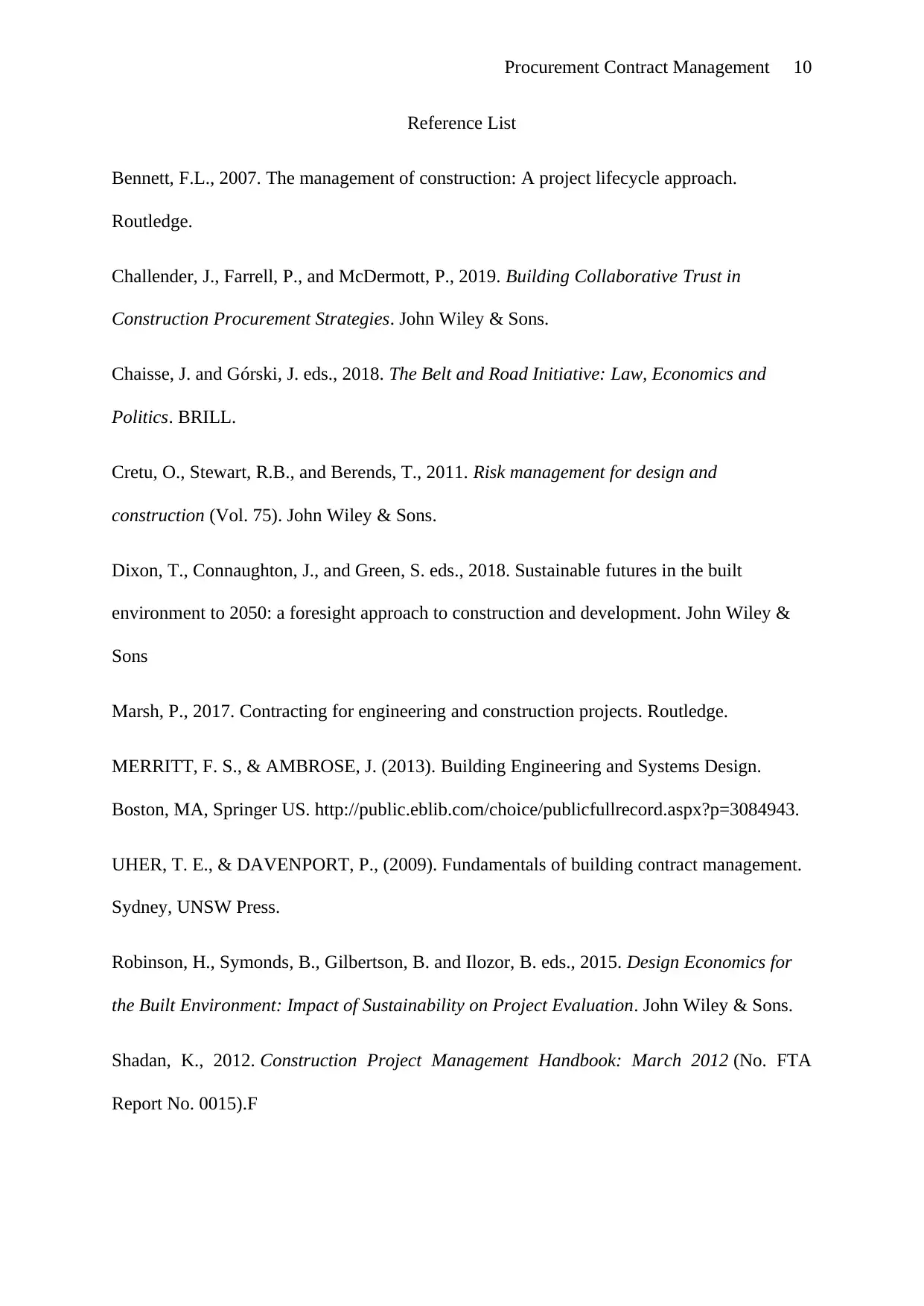
Procurement Contract Management 10
Reference List
Bennett, F.L., 2007. The management of construction: A project lifecycle approach.
Routledge.
Challender, J., Farrell, P., and McDermott, P., 2019. Building Collaborative Trust in
Construction Procurement Strategies. John Wiley & Sons.
Chaisse, J. and Górski, J. eds., 2018. The Belt and Road Initiative: Law, Economics and
Politics. BRILL.
Cretu, O., Stewart, R.B., and Berends, T., 2011. Risk management for design and
construction (Vol. 75). John Wiley & Sons.
Dixon, T., Connaughton, J., and Green, S. eds., 2018. Sustainable futures in the built
environment to 2050: a foresight approach to construction and development. John Wiley &
Sons
Marsh, P., 2017. Contracting for engineering and construction projects. Routledge.
MERRITT, F. S., & AMBROSE, J. (2013). Building Engineering and Systems Design.
Boston, MA, Springer US. http://public.eblib.com/choice/publicfullrecord.aspx?p=3084943.
UHER, T. E., & DAVENPORT, P., (2009). Fundamentals of building contract management.
Sydney, UNSW Press.
Robinson, H., Symonds, B., Gilbertson, B. and Ilozor, B. eds., 2015. Design Economics for
the Built Environment: Impact of Sustainability on Project Evaluation. John Wiley & Sons.
Shadan, K., 2012. Construction Project Management Handbook: March 2012 (No. FTA
Report No. 0015).F
Reference List
Bennett, F.L., 2007. The management of construction: A project lifecycle approach.
Routledge.
Challender, J., Farrell, P., and McDermott, P., 2019. Building Collaborative Trust in
Construction Procurement Strategies. John Wiley & Sons.
Chaisse, J. and Górski, J. eds., 2018. The Belt and Road Initiative: Law, Economics and
Politics. BRILL.
Cretu, O., Stewart, R.B., and Berends, T., 2011. Risk management for design and
construction (Vol. 75). John Wiley & Sons.
Dixon, T., Connaughton, J., and Green, S. eds., 2018. Sustainable futures in the built
environment to 2050: a foresight approach to construction and development. John Wiley &
Sons
Marsh, P., 2017. Contracting for engineering and construction projects. Routledge.
MERRITT, F. S., & AMBROSE, J. (2013). Building Engineering and Systems Design.
Boston, MA, Springer US. http://public.eblib.com/choice/publicfullrecord.aspx?p=3084943.
UHER, T. E., & DAVENPORT, P., (2009). Fundamentals of building contract management.
Sydney, UNSW Press.
Robinson, H., Symonds, B., Gilbertson, B. and Ilozor, B. eds., 2015. Design Economics for
the Built Environment: Impact of Sustainability on Project Evaluation. John Wiley & Sons.
Shadan, K., 2012. Construction Project Management Handbook: March 2012 (No. FTA
Report No. 0015).F
Paraphrase This Document
Need a fresh take? Get an instant paraphrase of this document with our AI Paraphraser

Procurement Contract Management 11
Van Weele, A., 2014. International contracting: contract management in complex
construction projects. World Scientific.
Whyte, A., 2014. Integrated design and cost management for civil engineers. Crc Press.
Van Weele, A., 2014. International contracting: contract management in complex
construction projects. World Scientific.
Whyte, A., 2014. Integrated design and cost management for civil engineers. Crc Press.
1 out of 11
Related Documents
Your All-in-One AI-Powered Toolkit for Academic Success.
+13062052269
info@desklib.com
Available 24*7 on WhatsApp / Email
![[object Object]](/_next/static/media/star-bottom.7253800d.svg)
Unlock your academic potential
© 2024 | Zucol Services PVT LTD | All rights reserved.





